Chelsea and Palmeiras faced off in the Club World Cup final after winning their respective continental competitions. Both clubs looked to win the competition for the first time in their history, and for Chelsea, it was only title missing in the Abramovich era. Despite Chelsea’s strong favouritism, they had much difficulty breaking down Abel Ferreira’s low defensive block. In the 117th minute, Kai Havertz converted the game-winning penalty after an unfortunate handball from Luan.
Thomas Tuchel’s tactics were simple; dominate possession and keep Palmeiras from creating chances. Understanding Chelsea’s superiority, Abel’s side were happy to sit in a compact low block and take advantage of counterattacks. After Lukaku’s goal in the 55th minute, Palmeiras were forced to attack more and consequently found the equaliser in Veiga’s penalty. For the majority of the match though, Chelsea controlled possession and looked to break down Palmeiras’ defensive structure.
In this tactical analysis, we will examine why Abel’s tactics were so difficult to break down and the successful tactical tweaks Tuchel made to win the match.
Lineups
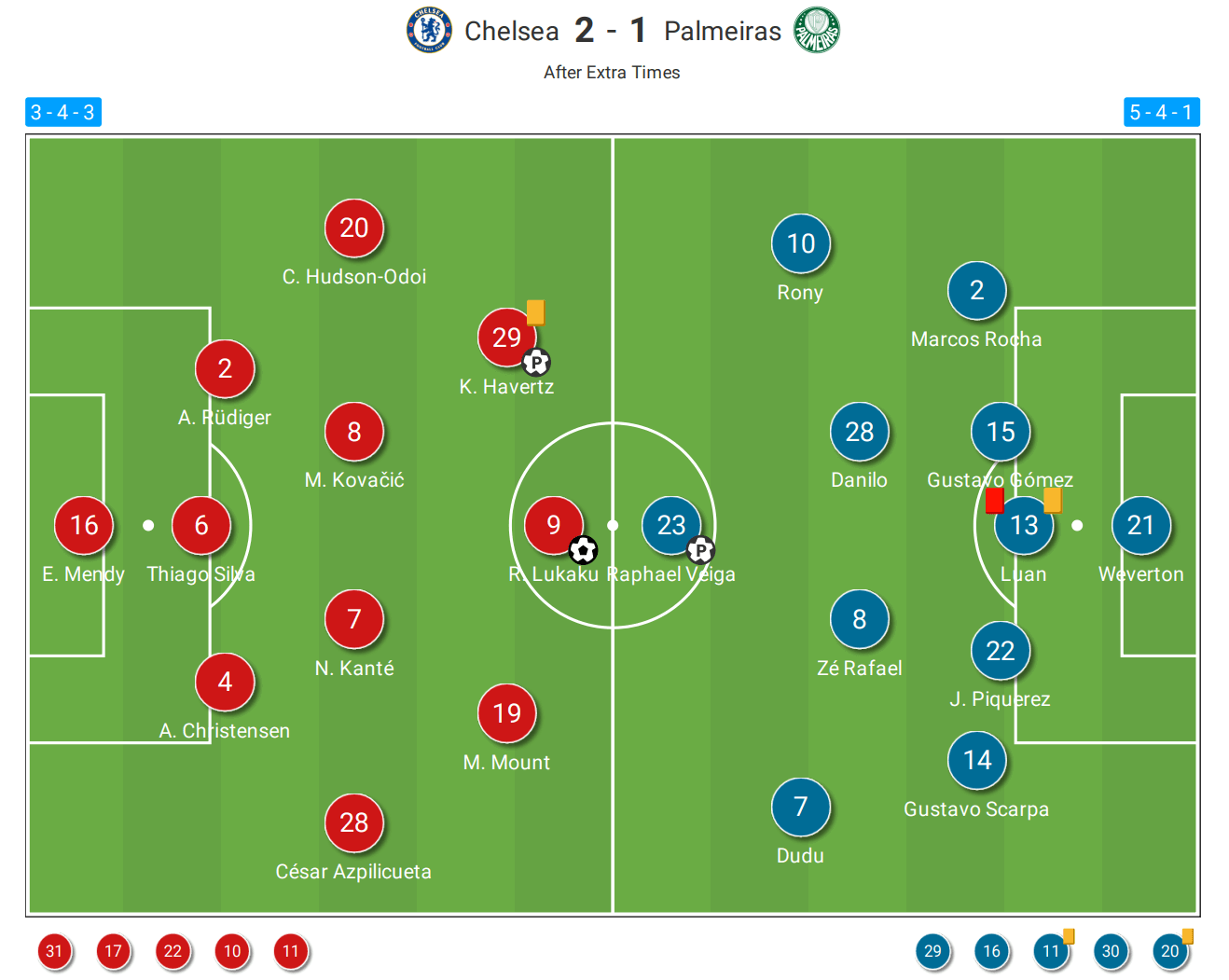
Thomas Tuchel made four changes from the starting eleven that faced Al-Hilal on Wednesday. Hudson-Odoi was brought on for Alonso, Kante for Jorginho, and Mount for Ziyech. Finally, Mendy returned after winning the AFCON with Senegal. Chelsea lined up in their usual 3-4-2-1 but changed to a 3-4-1-2 still in the first half. More on that later.
Abel Feirrera kept the same eleven from the 2-0 win against Al Ahly on Tuesday. Although the starting formation is a 5-4-1, this would change according to the phases of the game. Gómez, Luan, and Piquerez were the central defenders alongside Scarpa and Rocha. Zé Rafael and Danilo formed the midfield duo flanked by Dudu and Rony. Raphael Veiga played more advanced.
High Press
Chelsea dominated possession with 68.2% of the ball. Furthermore, they completed 689 passes from 779 attempts. This overall domination was made possible by their effective high press. With the ball, Palmeiras attempted to build out of the back and construct their attacks. This was made nearly impossible by Chelsea as they kept an impressive PPDA of 4.71. Consequently, Palmeiras averaged 2.38 passes per possession and rarely entered Chelsea’s own third. The only chances they were able to create came through counterattacks.
Chelsea were very aggressive in their defensive organisation. As Palmeiras set up in a 3-4-1-2 with the ball, it was easy for Chelsea to mirror that. They were not worried about leaving an extra defender to cover space and marked Palmeiras man for man. Lukaku, Mount, and Havertz looked to pressure the central defenders while Odoi and Azpilicueta advanced on their wing-backs. Kante and Kovačić matched Danilo and Zé Rafael.
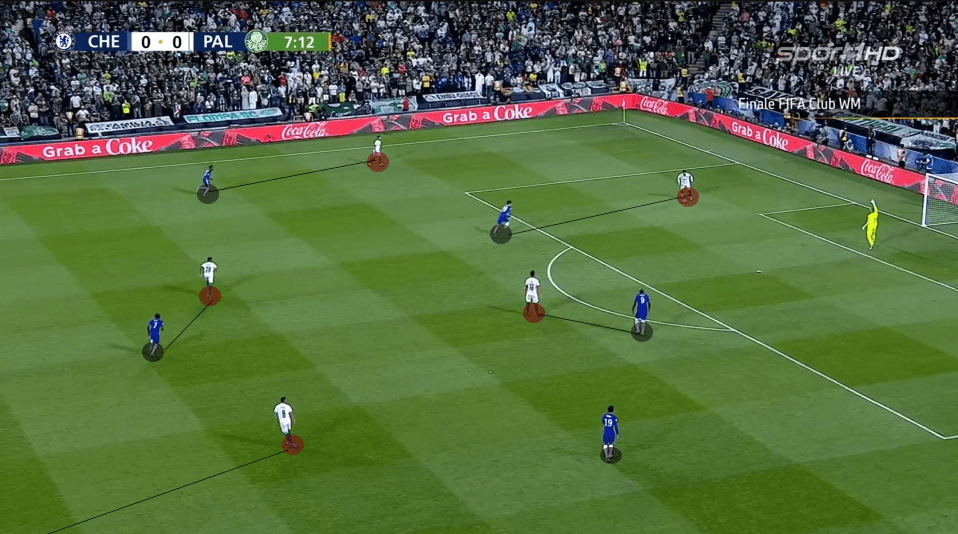
With their pressing angles, Chelsea looked to force Palmeiras wide and use the touchline as an extra defender. Once cornered, Tuchel’s men looked to win the ball or force them long. Chelsea have some of the best defenders in the world and won nearly every first ball.
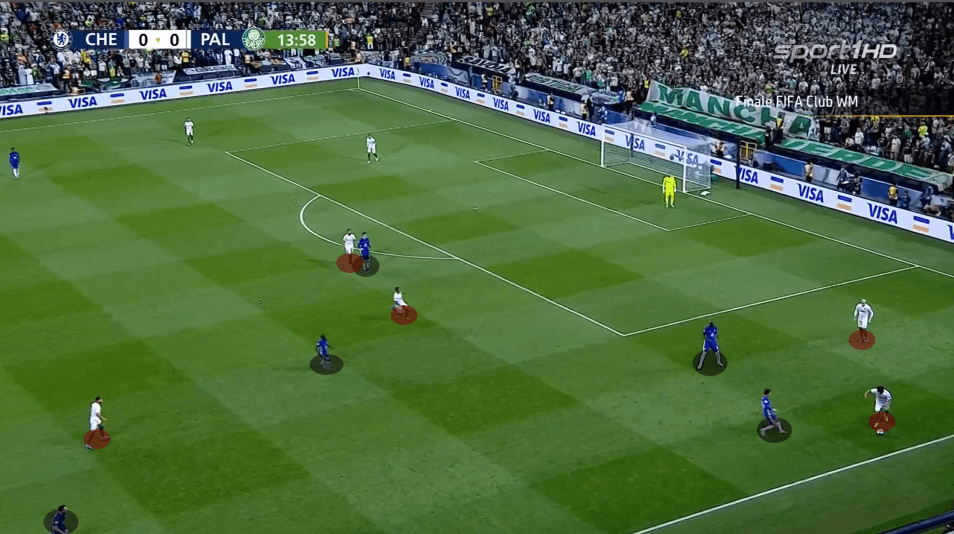
Below is yet another example of how Chelsea looked to press high through man-marking. They were very organised and rarely played through.
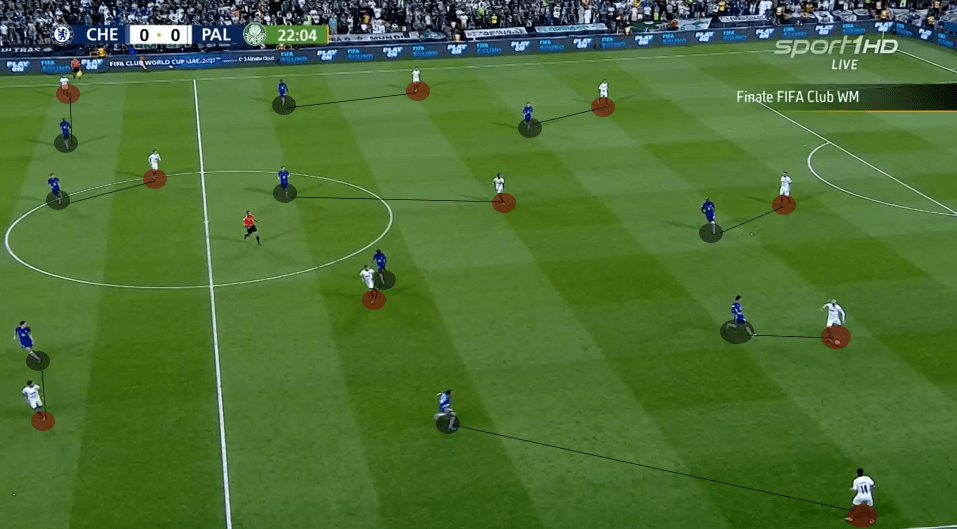
In addition to their high press system, Tuchel looked to eliminate Palmeiras’ counterattacks with their counter-press. The German is famous for implementing very successful counter-pressing systems in his teams. Counter-pressing systems are usually ball, man, or space-oriented. Tuchel’s, however, is a mixture. The players nearest to the ball instantly press the ball carrier while others close passing lanes. This system is very effective as it keeps the opposition from combining out while still applying pressure to the ball carrier.
In the example below, Havertz and Kovačić are applying pressure on Rony while Kante tracks the nearby runner. While they were successful for the most part, Palmeiras did have a few dangerous counterattacks.
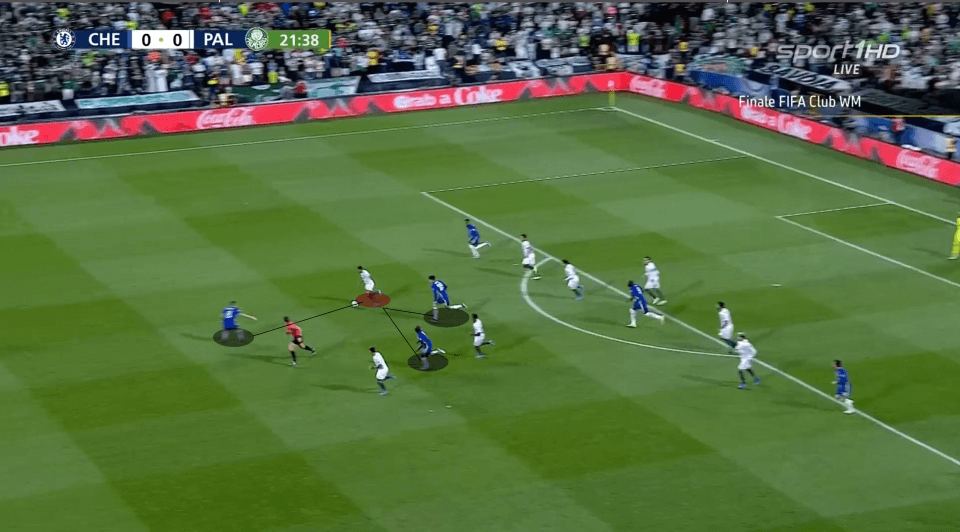
Palmeiras’ low block
While Chelsea dominated possession, they struggled to create good chances. Abel deployed a very effective defensive organisation that neutralised Chelsea’s midfield. As a consequence, Chelsea were unable to create clear goal-scoring opportunities. Nearly every shot faced numerous defenders in front. Additionally, they often settled for long-distance attempts and had an average shot distance of 20.37 meters. This struggle for clear chances can be illustrated by their shot map below.
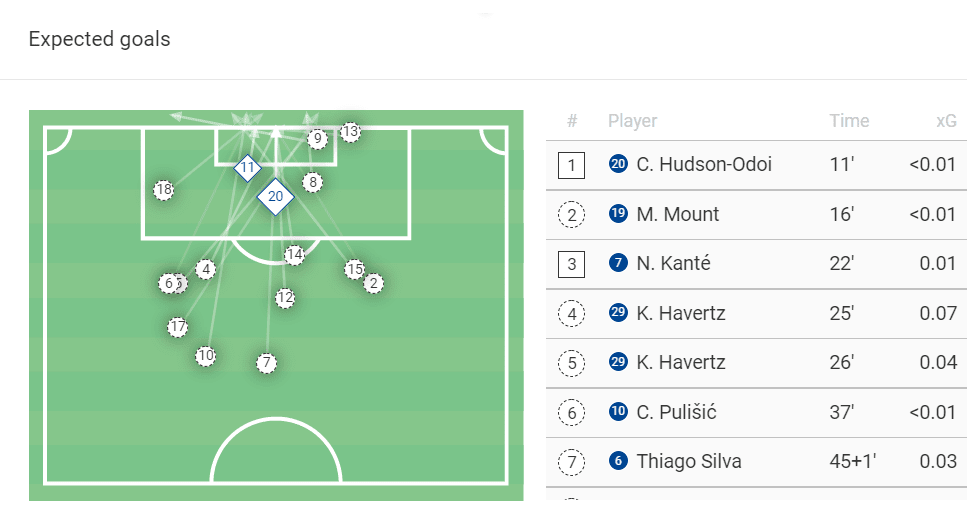
As Palmeiras’ low block was able to neutralise Chelsea’s midfield, the majority of their possession was amongst their central defenders. From the 779 passes attempted, 318 were lateral. Their pass map below illustrates this with the thick links between central defenders. Rüdiger and Thiago Silva completed 66 passes between them.
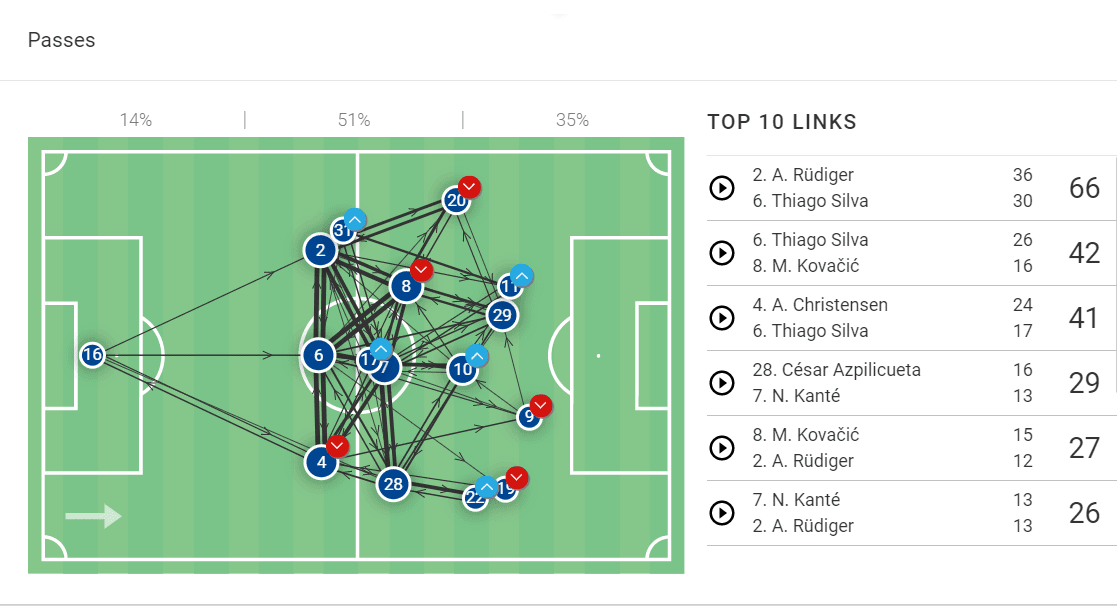
Palmeiras equally adapted a man-marking defensive system but always left an extra defender to cover. As a result, they often organised in a 6-2-2. Rony was sacrificed and marked Hudson-Odoi on the right side. Rocha and Piquerez were in charge of the attacking midfielders, Havertz and Mount. Luan and Gómez were in charge of Lukaku and providing cover. Scarpa was tasked with Azpilicueta on the left side. In the middle, Danilo and Zé Rafael man-marked Kante and Kovačić. Below is an illustration of their defensive structure. Notice how Rocha and Piquerez follow their man into the midfield.
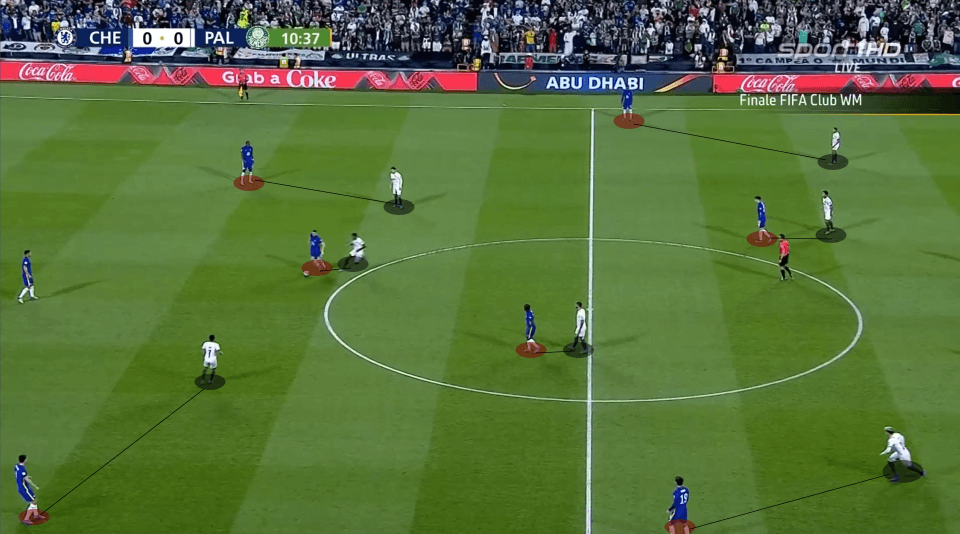
The image below is another example of their defensive structure. This time, Piquerez is even higher tracking Mount.
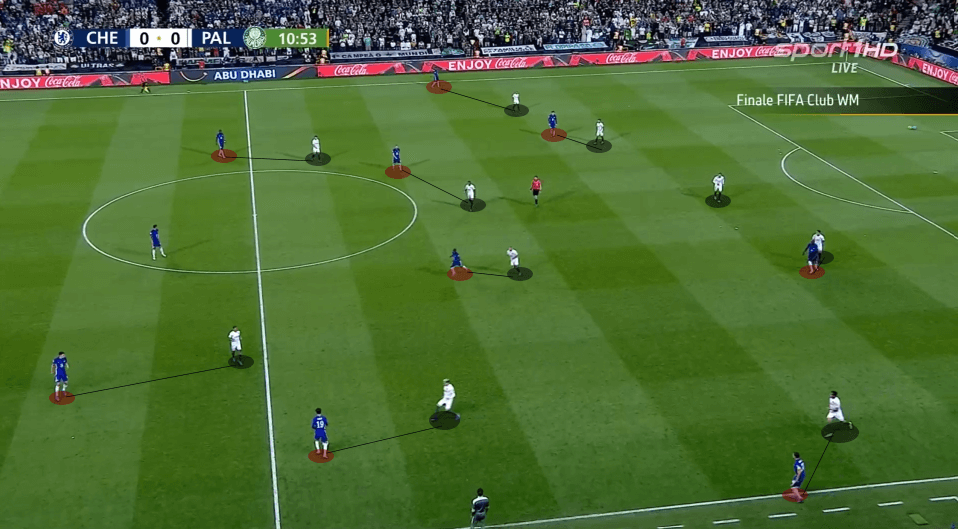
This defensive system was highly effective because it provided Palmeiras with numerical superiority in the midfield. With Dudu and Veiga sitting deeper, Palmeiras had a 4v2 in the middle. Chelsea was missing the link from the defenders to the attackers.
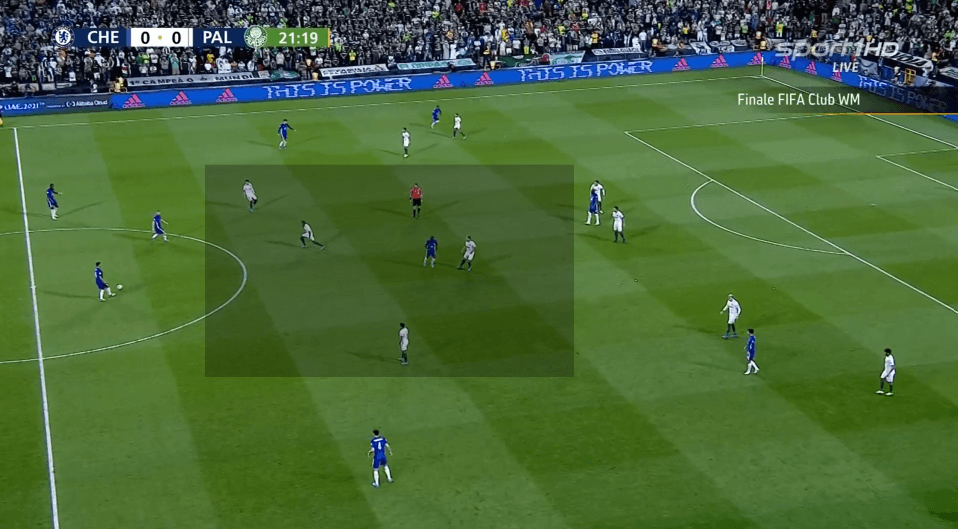
Chelsea’s attacking line of five provided depth but were missing the link from the defenders. Kovačić and Kante struggle to find space between the lines as they were being tightly marked by Palmeiras’ midfielders. The image below highlights the hole in the midfield, and how no Chelsea player was looking to attack it.
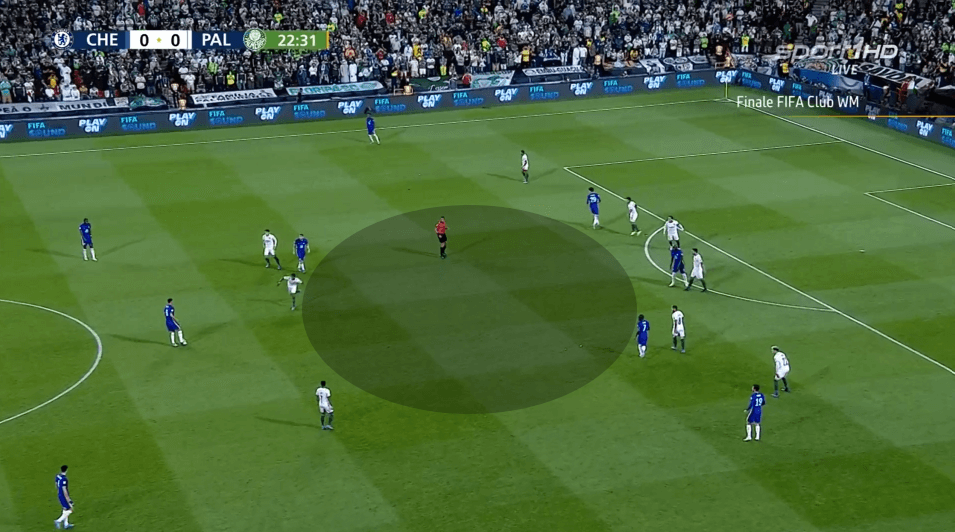
Chelsea’s two attacking midfielders, Havertz and Mount, were not doing a good job. They often sat in the defensive line and did not get involved. Once again, notice the space in the midfield, and how Mount and Havertz sat in the half-spaces rather than attack the central lane. As a result, Chelsea struggled to create clear chances and often kept harmless possession.
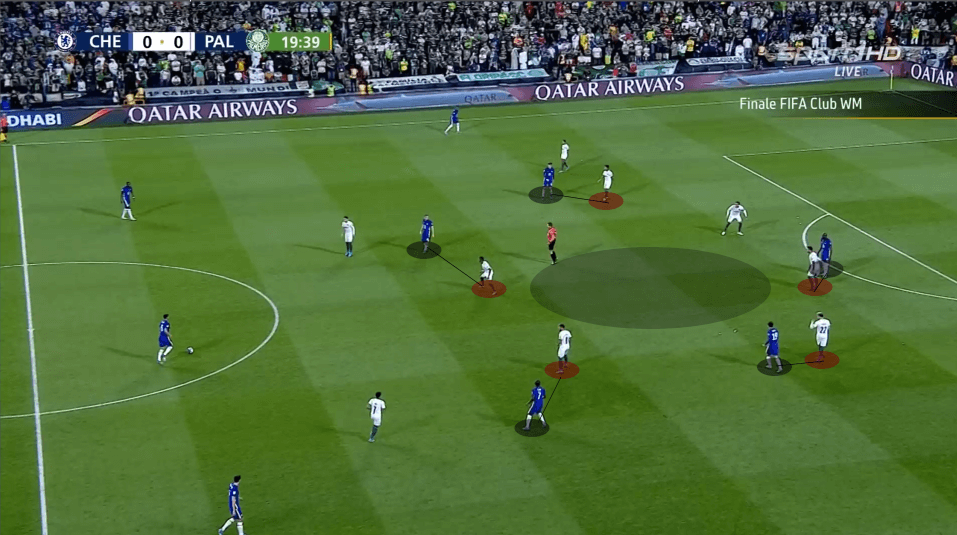
Introduction of Pulisic
In the 31st minute, Mason Mount came off injured for Christian Pulisic. Realising the space to be taken in the midfield, Tuchel introduced the American as a number 10 and pushed Havertz up top. This changed Chelsea’s structure to a 3-4-1-2. This change was crucial as Chelsea became much more dangerous and had more success in disorganising Palmeiras’ defensive structure.
With a single attacking midfielder, Kante and Kovačić now looked to occupy the half-spaces rather than the centre. As Palmeiras were man-marking, this move opened up a huge lane in the centre of the pitch. Pulisic looked to receive the ball in this space and attack the defensive line. As Pulisic positioned himself more centrally, Piquerez was unable to stay on him. Chelsea regained control of the midfield.
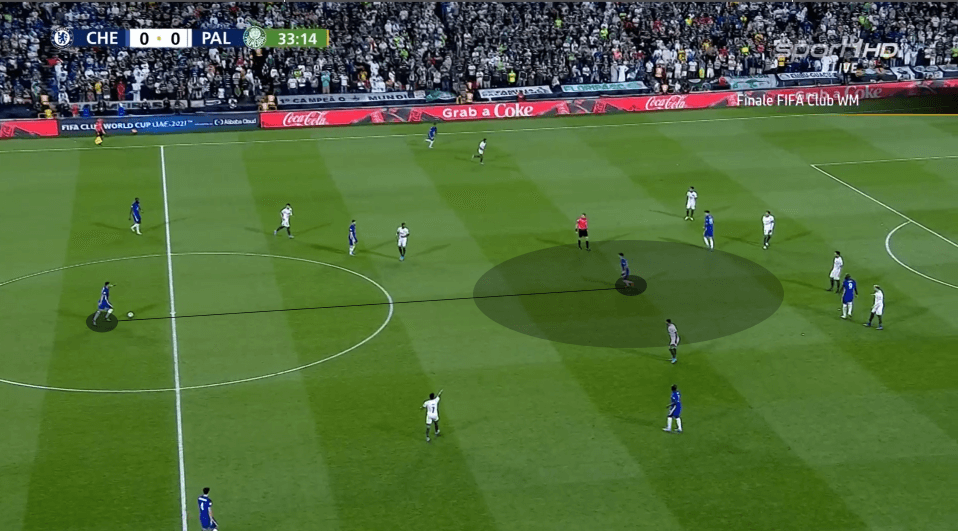
Pulisic was very successful in moving between the lines and finding passing lanes. This movement caused Palmeiras a lot of trouble as Chelsea were now able to attack the box with more threat. Below, he moves to the left half-space to receive a ball from Thiago Silva. He is able to turn and drive at the defence in a dangerous position.
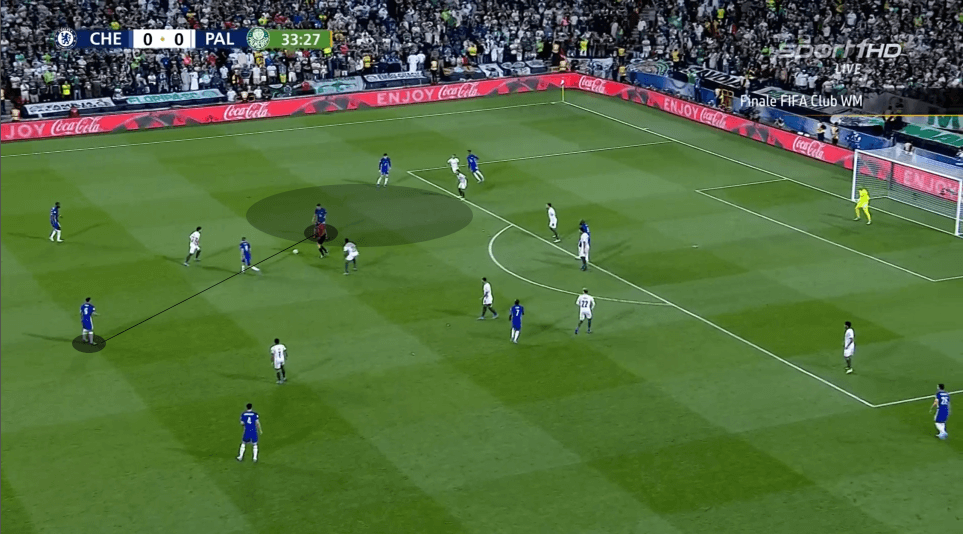
Even after half-time, when Palmeiras were able to restructure the midfield and deal with him, he was still causing danger. In the instance below, he makes a pass to Christensen and instantly attacks the space to receive a layoff from Lukaku. Overall, Pulisic’s introduction made Chelsea’s midfield more dynamic and dangerous. They were able to attack and manipulate space to create better chances.
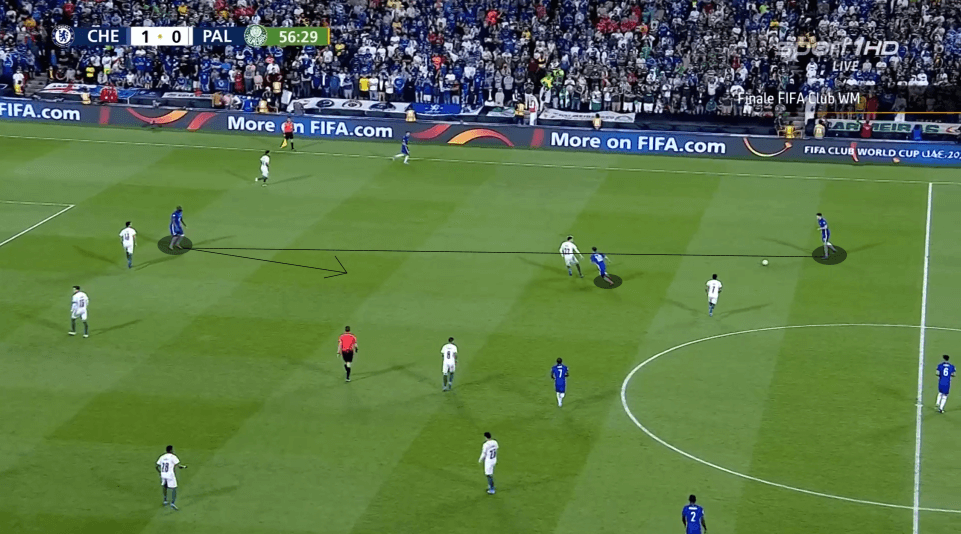
Thiago Silva’s role
Despite conceding a penalty with an accidental handball, Thiago Silva was named the player of the competition. He played a crucial role in Jorginho’s absence and was Chelsea’s playmaker. His role in this match was similar to the one David Luiz used to play at Chelsea. As Palmeiras kept an extra player for cover in the defensive line, this meant Tuchel’s side had numerical superiority in the first line of attack. Thiago Silva often had time and space on the ball and looked to take advantage of it. With Palmeiras’ midfield being pinned by Chelsea’s, Thiago Silva was able to drive forward and make a dangerous lob for Havertz in the box.
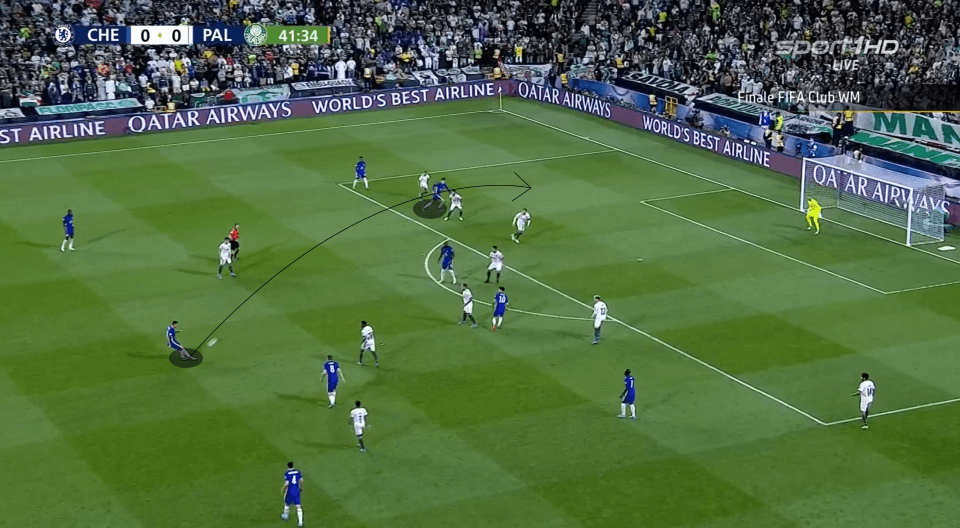
This time from a deeper position, Silva launches a great long-ball for Hudson-Odoi in behind.
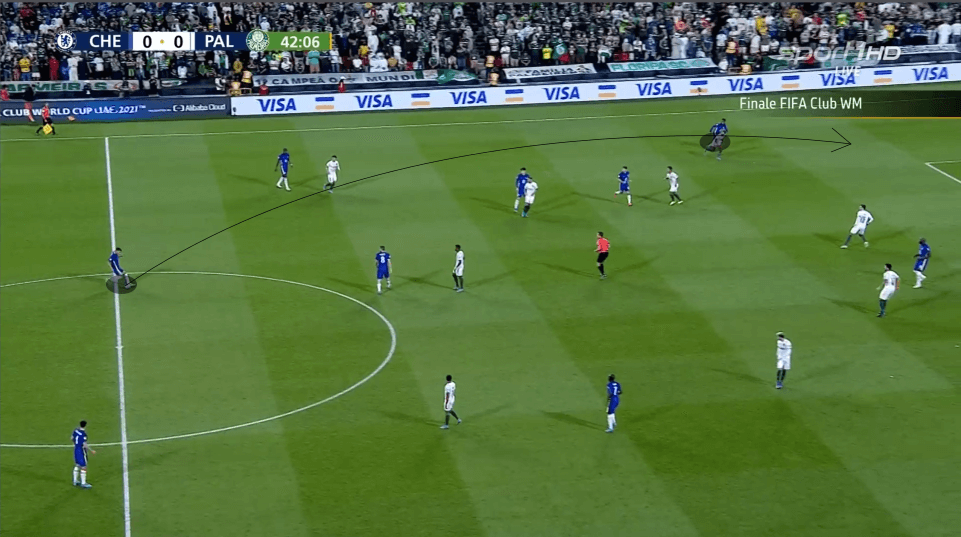
As previously stated, there was a missing link from Chelsea’s defenders to their forwards. Pulisic’s introduction helped in that, but it was Thiago Silva that made a lot of difference. Similar to Jorginho, he would get on the ball in the midfield and look to progress through the zones by breaking lines with his passing. In the pass below to Lukaku, he is able to break two defensive lines and enter the final third.
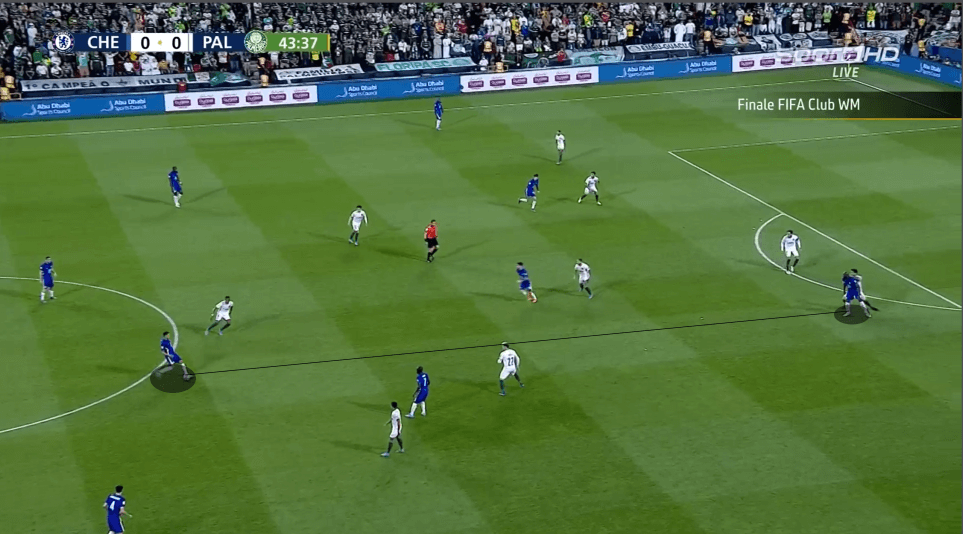
Attacking through the wings
Another strategy Tuchel’s men used to break Palmeiras’ low block was attacking through the wings. Hudson-Odoi replacing Alonso meant Chelsea were much more dangerous on the left-wing. In addition, he was being defended by Rony, who is far from a defender. Chelsea looked to isolate him on the wing to create 1v1 opportunities. Below is an example where Hudson-Odoi receives the ball wide and looks to take Rony on.
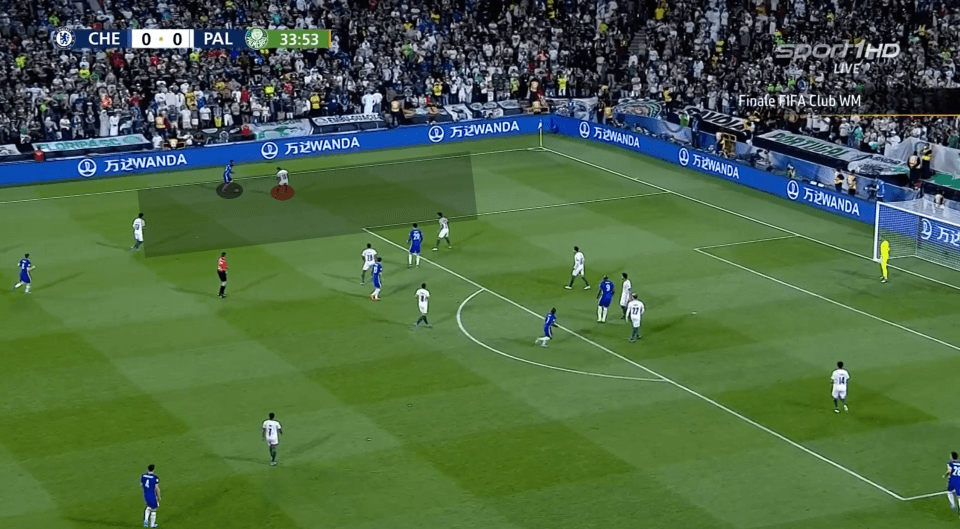
On the right-hand side, Azpilicueta was not as dangerous as Hudson-Odoi. Consequently, they looked to create numerical superiority wide with Christensen pushing up and Kante coming over. Throughout the match, Chelsea’s most dangerous chances came from wide.
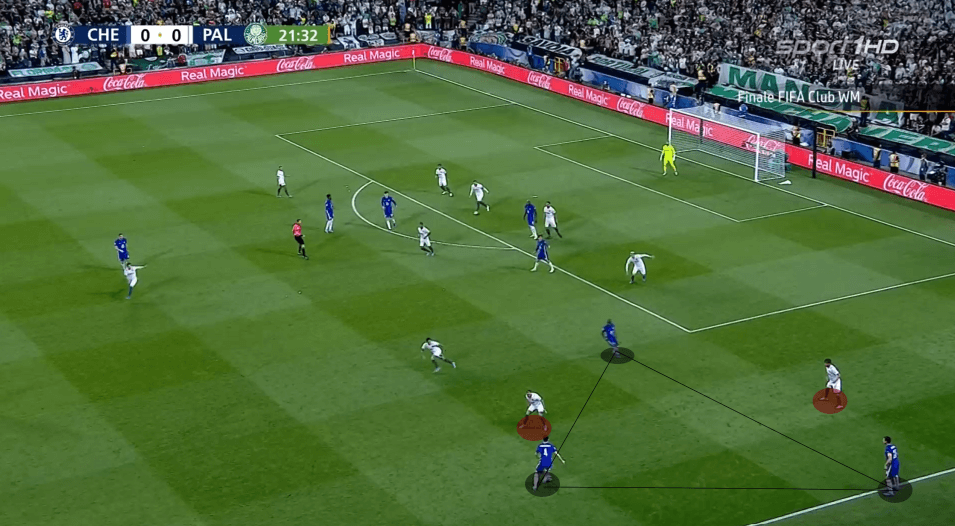
Unsurprisingly, Chelsea’s goal came through the wide areas. Havertz drops very deep into the midfield in an effort to drag Rocha out of position. This movement isolates Hudson-Odoi with Rony on the wing.
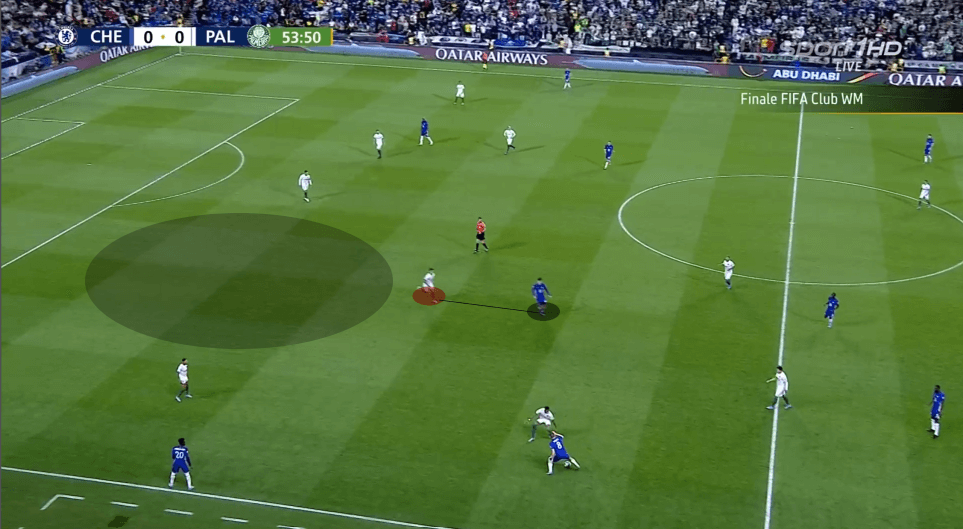
Kovačić is able to beat Danilo on the dribble and create a 2v1 on the wing against Rony, an incredibly desirable situation.
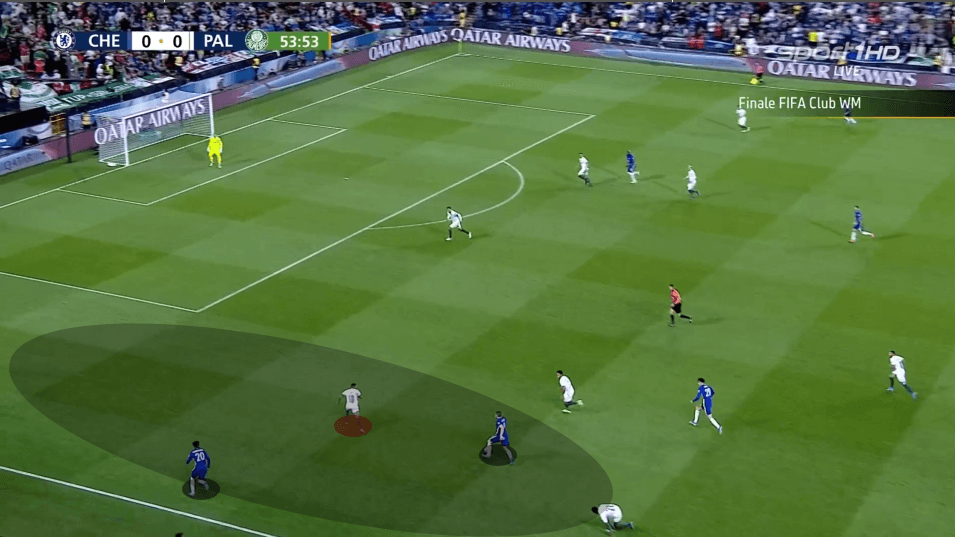
Hudson-Odoi is able to beat Rony and find space for a cross. He finds Lukaku making a run into the six-yard box and delivers an excellent cross to his head. One of the best finishers in the world, Lukaku scores to make it 1-0.
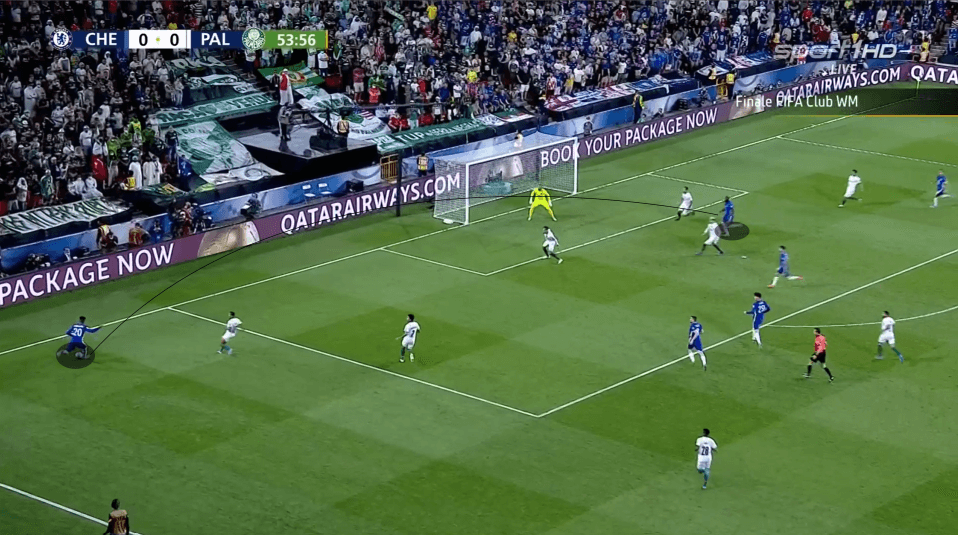
Conclusion
Abel Ferreira’s tactics made Chelsea’s life very difficult. He deployed a compact low block that neutralised Chelsea’s midfield and kept them from creating chances. The introduction of Pulisic and the role of Thiago Silva were key in overcoming that, but the most success came from attacking the wide areas. It was a hard-fought battle between two great managers, where an accidental handball by Luan decided the game. While Palmeiras lacked offensively, they should be proud of their defensive efforts. Chelsea will be happy to add the last missing trophy to the cabinet.





Comments